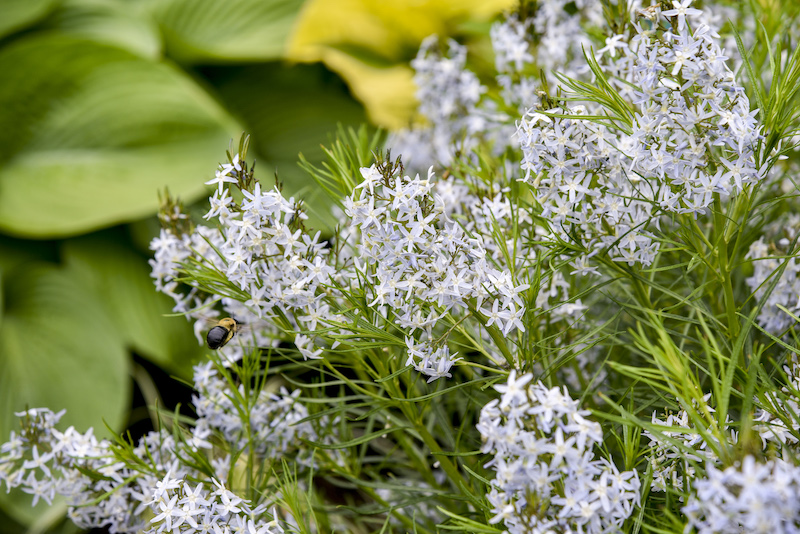Amsonia is an easy-to-grow native plant that is not often bothered by pests or diseases. The finely leaved stems stay compact and dense through the summer and turn brilliant shades of yellow for the fall. Although this is a beautiful plant to add to a garden plan, it is considered mildly toxic and should be kept away from pets and children and handled with care when pruned or dug up. Like all plants in the Oleander family, Amsonia exudes a milky sap that contains latex and can be quite irritating.

Is Amsonia Poisonous to Children?
Skin irritation may result from touching a bruised or cut stem of Amsonia. The oozing, milky sap contains latex, which can be a problem for anyone with a latex allergy or sensitive skin. Children should always be kept out of the area when the plants are being cut back for the fall. Any cut stems left on the ground could still contain enough latex sap to cause skin irritation or mouth irritation if put in the mouth.
Is Amsonia Poisonous to Dogs?
Dogs who chew on plants should be kept away from Amsonia and its irritating sap. A rash or burn on the dog's mouth and muzzle could result from eating the stems and foliage. While Amsonia is not listed by the ASPCA as being highly toxic to dogs, smaller breeds and puppies may be more affected by ingesting the plant because of their small size. Always contact your veterinarian if you suspect that your dog or puppy has eaten any amount of an Amsonia plant.
Is Amsonia Poisonous to Cats?
Cats who are regularly outdoors may try to chew on Amsonia. The milky, latex sap is very bitter, but it can be irritating even if small amounts are ingested by a cat. Redness on the face, where the cat may have brushed against damaged stems, or redness of the mouth could indicate irritation from Amsonia plants. Any unusual symptoms such as vomiting, diarrhea, or loss of coordination should be reported to your veterinarian as soon as possible.
Is Amsonia Poisonous to Other Animals?
Typically livestock such as sheep, cows, or goats are not bothered by Amsonia sap and rarely choose to graze on the plants. Horses are also not likely to be affected by the sap of the stems.
Symptoms Of Amsonia Poisoning
Always check with your doctor or veterinarian for guidance if you suspect Amsonia poisoning.
Here are some common symptoms to look out for:
- Contact dermatitis
- Redness in the mouth or on lips
- Abdominal upset such as diarrhea or vomiting
Preventing Amsonia Poisoning
To prevent skin irritation in children and pets, always dispose of any pruned stems immediately instead of leaving them on the ground. Grow the plant in areas less accessible to children and pets. Keeping Amsonia away from outdoor cats who roam can be more difficult, but planting it away from areas of heavy traffic is a good start.
Pet Poison Helpline
If something were to happen to your furry friend, and you suspect that they are suffering from Amsonia poisoning, there is a poison control hotline to call for 24/7 vet advice. It is called the Pet Poison Hotline, and their phone number is (855) 764-7661.
Sources:
"Plant of the Week: Arkansas Blue Star." The University of Arkansas System Division of Agriculture. uaex.uada.edu
"Willowleaf bluestar, Amsonia tabernaemontana." Wisconsin Horticulture, Division of Extension. hort.extension.wisc.edu
 |
Author Robbin Small - Published 6-07-2023 |
